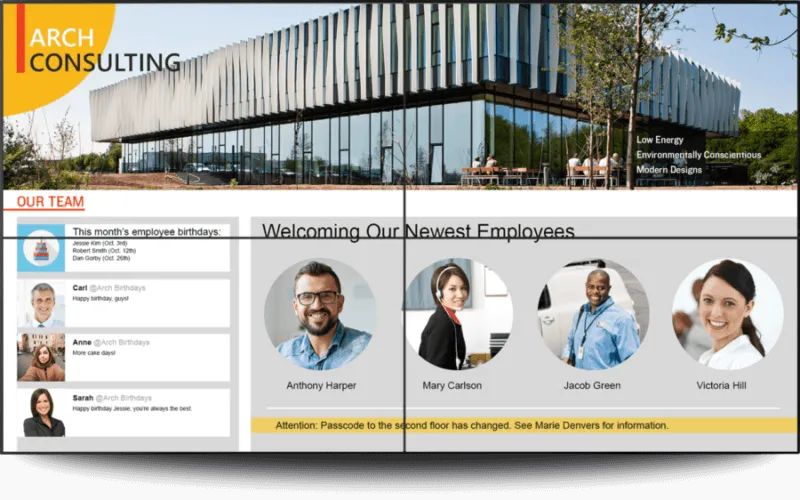3 Tips for Designing Content for a Video Wall
In many ways, video walls are unique among digital signage solutions. They tend to be big projects, with numerous screens, hardware assets, and content options required for even the smallest installations. But in other ways, video walls are no different than any standard digital signage project.
Like all digital signage, a video wall is only as good as its content. Many of the best practices for digital signage content creation hold true for video walls. Here are 3 best practices for designing content for a video wall:
1.Planning for Tech Specifications
First, determine the scope of the project and its key specifications. What type of displays will be used? LED vs LCD? Or maybe video projectors? These days, most projects work off of LEDs due to their color uniformity, long life, and range of optimal viewing angles, but different use cases may require different technologies. Second, you'll need some answers from the video wall technician regarding:
- Display size
- Pixel pitch
- Screen resolution
- Contrast / brightness
- Dimensions/depth of the individual displays
- Viewing distance
These factors play a key role in content creation. They will determine how the content will be rendered, whether to use large or small text, motion graphics, etc.
2. Video Wall Content Creation
With the technical details figured out, the content creation process can begin. Start by looking at existing assets and see what types of content the company already has. If the brand has used digital signage extensively in the past, there may be content templates that can be reused. But in most cases, companies will design their content for a video wall from scratch.
Know the Content’s Goals
First, consider the goal of the content. Is the video wall being temporarily installed for a trade show? Will it be a permanent fixture inside a hotel lobby? The video wall’s purpose will dictate its content, so businesses need to put themselves in their audiences’ shoes and figure out what they want to see.
Determine the Content Scope
Generally, content for a video wall works best when the focus is on one main piece of content surrounded by "complementary content" such as weather, scrolling text, etc. The trick here is to design with big in mind. When there is too much content being displayed on a video wall, the viewer experience is impacted negatively. Typically, companies will want to stick to several large-scale videos, images, or guided narratives on their video walls. Trying to communicate too much all at once can be distracting and off-putting, which reduces the impact of the video.
Best Practices for Messages
As a rule, content for a video wall should be short and to the point. It's easy to assume that big screens can handle large amounts of text; if anything, big screens highlight the wordiness of huge text blocks even more than smaller screens, which tends to turn people off.
This is another area where it pays to know the audience. While captive markets (like those in hospital waiting rooms, for example) might be able to read longer-form messaging, audiences in the lobby or walking in a mall. These markets won’t have time to stop and read a lengthy, multi-page message, even if the screen is huge. As best practices, video wall content managers should stick to the following tips:
- Structure the visual hierarchy for content so that the most important message is listed first
- Use short content messages that are easy to take in at a glance
- Use a large font that can be seen from far away
- Show smooth, slow-moving video that’s easy on the eyes

3. Consider Long-Term Plans
A crucial part of the digital signage video wall investment is the company’s long-term plan. Is the video wall permanent? Will consultants be brought on to produce new content over time? Who’s responsible for the ongoing support and maintenance of each screen?
And what about future digital signage goals? Will the company exclusively stick to visual signage? Or will they eventually upgrade to kiosks and other forms of signage that users can interact with?
The point here is that content for the overall digital signage network (which includes digital signage screens, video walls, and kiosks) should be budgeted for.
Content for a Video Wall
Keep in mind that a video wall serves multiple functions. Yes, it’s an effective communication platform for customers, employees, and visitors, but it’s also an investment in aesthetics that can bring serious value to a company’s image. And beyond that, the video wall can be an effective revenue source by way of advertising opportunities and increased property values.
Video walls can display aesthetically pleasing visuals and rich content. This form of digital signage is ideal for enhancing customer experience, which can ultimately lead to higher revenues. Companies considering a video wall investment should use the above tips as a guide, and plan out their project from start to finish before beginning.







